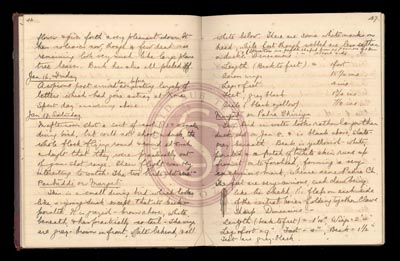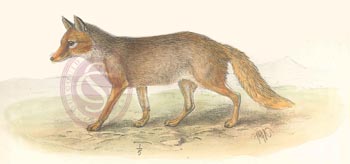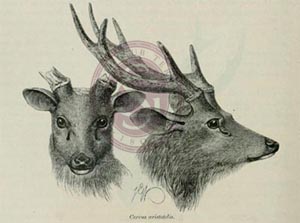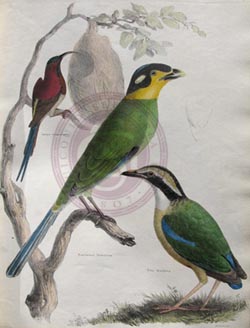 |
|
Diary (1902-1904): 14th-17th January 1903 (p.46-47) [LDGSL/348/2/3]. Click to enlarge.
|
Fermor frequently wrote about the wildlife, trees and plants he saw on his travels, demonstrating an interest in the natural world that is also shown in one of his other notebooks in the Geological Society’s collections – a volume containing butterfly observations. At the time Fermor was in India the areas he was passing through, referred to by him as forest or jungle, were rich in plant and animal life. His first field work season was spent in a region called Dhar forest, an area which is now mostly covered in fields. It appears that some villages he visited during this time no longer even exist, flooded by the Indira Sagar Reservoir.
 |
|
A fox similar to the type of fox Fermor describes. [WT Blanford, Eastern Persia: an account of the journeys of the Persian Boundary Commission, 1870-71-72. Vol.2: The zoology and geology, London: Macmillan, 1876 (pl.2).] |
This extract is typical of Fermor’s descriptions of the environment around him:
I went via the jungle to the N.E. of Pangri [Pangdi] and here on the D.T. [Deccan Trap] hills the grass was exceedingly long and of several kinds among which spear-grass and the scented grass were noticeable. The camp at Nautar [Nauthal] was pitched in a clearing in the jungle, my tent being under a tamarind. I felt that I had again at last got to a really jungly place. All round were fine trees of various kinds including teak, and mowha palas and bair. There were some huge logs of mahua wood evidently recently cut and while I was looking at this a jackal stole across the clearing.
17th December 1903
 |
| A young male Sambar, a type of deer often mentioned by Fermor. [PL Sclater, ‘On certain Species of Deer now or lately living in the Society’s Menagerie’, Transactions of the Zoological Society VII, London: Taylor and Francis, 1872, 333-352 (p.350 figs.7-8).] |
Trees such as palas (Flame of the Forest), pipal (Sacred Fig), mahua, and mango are the most oft-mentioned by Fermor, who regularly recorded the species of tree under which he was sleeping in his diary. His scientific mind is clear in the detailed descriptions and lists of the flora and fauna he observed, even including measurements of individual birds and animals in some cases.
The animals Fermor reports seeing are entirely different creatures to those with which he would have been familiar – monkeys for example, hyena, various types of antelope and deer, and even big cats. Nilgai (an antelope) and sambar (a deer) were relatively common sightings, while big cats were decidedly rarer. Typically the wildlife that Fermor mentions was seen briefly during the course of the day, but on some occasions he had the chance to observe animals from his camp, meaning he could note their behaviour more fully. He spends a full A5 page describing the activities of a colony of fruit bats found in a tree near his tent; they had ‘fox-like heads’, made noises ‘like a lot of dogs barking in the distance in different keys’, and at dusk became ‘more lively, crawling or rather climbing about upside down, taking short flights, and finally [...] flying away in search of food’ (18th January 1903).
 |
| Several birds similar to those Fermor describes. [John Forbes Royle, Illustrations of the botany and other branches of the natural history of the Himalayan Mountains, and of the flora of Cashmere. Vol.II – Plates, London: Wm.H. Allen & Co., 1840 (pl.7).] |
Many Indian birds, however, were similar to those found in Britain. Fermor writes of pigeons, ducks, snipe, and crows, albeit different varieties to those in Europe. More exotically, there were species such as the Little Bee-Eater, ‘a gymnast in the air in its endeavours to catch insects’ (8th November 1903), and parakeets.
The natural world often formed the subject for the occasional sketches included in the diary, usually as part of the description of a specific bird or insect. Click on the thumbnails below to see some of these sketches in more detail.
 |
|
Egg |
|
 |
|
Insect |
 |
|
Silk cocoon |
|
 |
|
Wing and feather |
 |
|
Bee and nest |
|
 |
|
Spider |